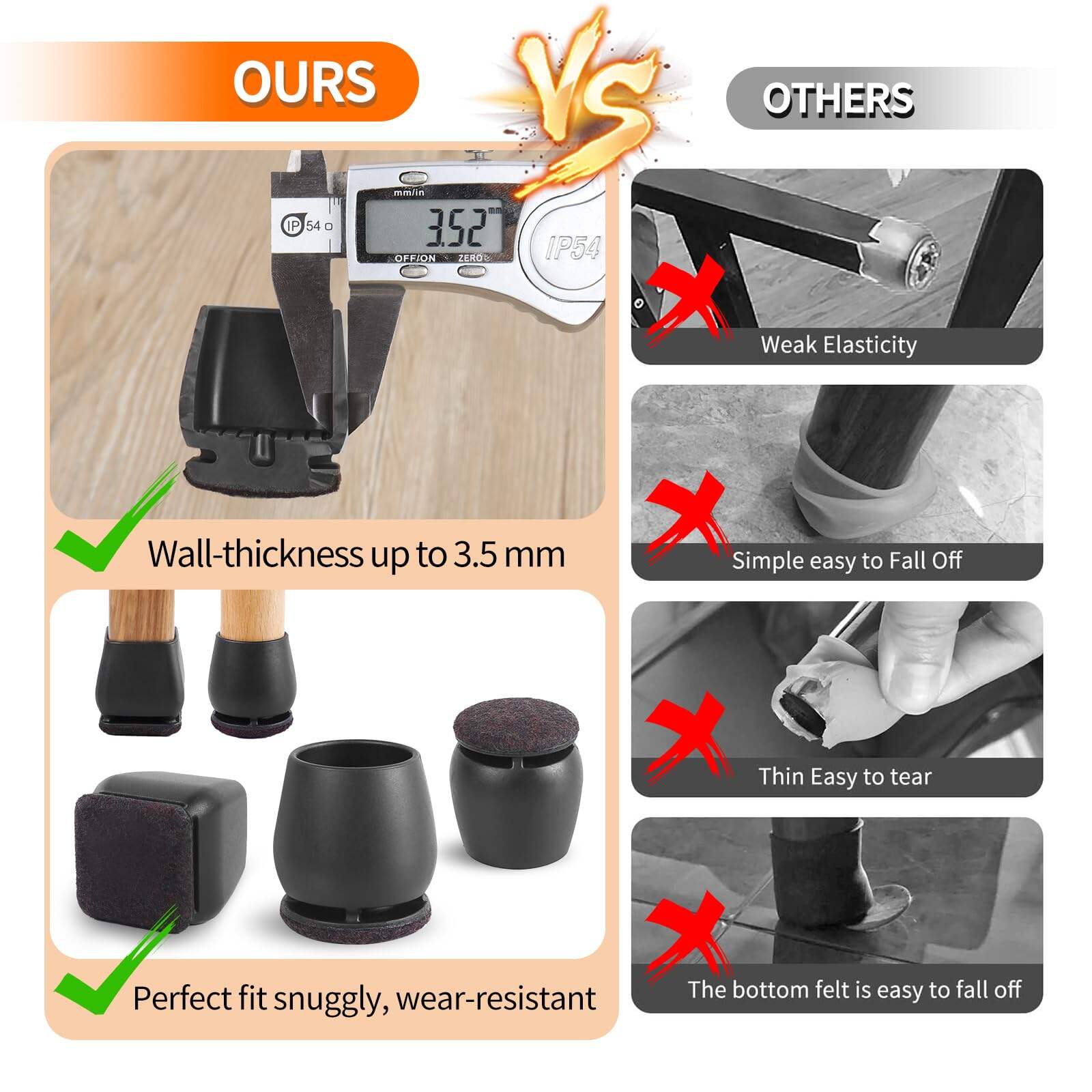لماذا تعتبر وسادات أقدام الكراسي عالية الجودة ضرورية لسلامة مكان العمل؟
فهم الدور الحيوي لحماية الكراسي في أماكن العمل الحديثة
في بيئات المكاتب الديناميكية اليوم، فإن التفاصيل التي تبدو بسيطة مثل وسائد أقدام الكرسي تلعب دورًا حيويًا في الحفاظ على سلامة مكان العمل وحماية الاستثمارات القيّمة في الأرضيات. إن هذه الإكسسوارات الصغيرة ولكن القوية تُعدّ الأساس لوظيفة الكرسي السليمة، والراحة الوظيفية في مكان العمل، وصيانة المرافق. وعندما تتجاهل المكاتب أهمية وسادات أقدام الكراسي، فإنها لا تتعرض فقط لخطر إتلاف الأرضيات باهظة الثمن، بل أيضًا لتعريض سلامة وراحة الموظفين للخطر.
تمتد آثار الحماية المناسبة للكراسي لما هو أبعد من مجرد الحفاظ على الأرضيات. فتساهم وسادات أقدام الكراسي عالية الجودة في تقليل الضوضاء في مكان العمل، وتحسين التنقّل، وتعزيز المظهر العام للمكتب. ومع تركيز المؤسسات بشكل متزايد على إنشاء بيئات عمل مثالية، أصبح فهم أهمية هذه الإكسسوارات الأساسية أمرًا بالغ الأهمية لمديري المرافق وأصحاب الأعمال على حد سواء.
العلم وراء تقنية وسادات أقدام الكراسي
ابتكار المواد والمتانة
تُدمج وسادات أقدام الكراسي الحديثة مواد متقدمة تم تصميمها خصيصًا لضمان المتانة والأداء. تمثل الأقمشة ذات الكثافة العالية، والمطاط المقوى، وخلائط البوليمرات الخاصة الطليعة في تكنولوجيا الوسادات. وتتعرض هذه المواد لاختبارات صارمة لضمان قدرتها على تحمل الضغط المستمر والحركة والظروف البيئية المختلفة مع الحفاظ على خصائصها الواقية.
يتميز جيل أحدث وسادات أقدام الكراسي بالتصميم متعدد الطبقات، الذي يجمع بين قواعد ناعمة صديقة للأرضيات وطبقات علوية قوية تقاوم الانضغاط والتآكل. ويُعد هذا النهج المبتكر وسيلة لتمديد عمر الوسادات نفسها وأثاثات الحماية التي تحميها، مما يوفر عائدًا استثماريًا متفوقًا للشركات.
التفاعل السطحي والتحكم في الاحتكاك
تعتمد فعالية وسادات أرجل الكراسي بشكل كبير على قدرتها في إدارة الاحتكاك بين أرجل الكرسي وأسطح الأرضيات. وتدمج التصاميم المتقدمة أنماطًا نصورية ومكونات متخصصة تُحسّن القبض دون التسبب في أي ضرر. ويضمن هذا التوازن الدقيق بقاء الكراسي مستقرة أثناء الاستخدام مع السماح بالحركة السلسة عند الحاجة.
يقوم خبراء الأسطح باستمرار بتحسين تركيبات الوسادات لتناسب مواد الأرضيات المختلفة، بدءًا من الخشب الصلب واللaminated وحتى السجاد والبلاط. ويضمن هذا التخصص حماية وفعالية قصوى عبر بيئات المكاتب المختلفة.
فوائد السلامة في مكان العمل وخفض المخاطر
الوقاية من حوادث الانزلاق والسقوط
تلعب وسادات أقدام الكراسي ذات الجودة العالية دورًا حيويًا في منع الحوادث في مكان العمل. عندما تفتقر الكراسي إلى حماية مناسبة للأرضيات، يمكن أن تنزلق بشكل مفاجئ، مما قد يؤدي إلى إصابات خطيرة. توفر وسادات أقدام الكراسي المصممة جيدًا القبضة اللازمة للحفاظ على ثبات الأثاث، وهي مهمة بوجه خاص في بيئات المكاتب سريعة الوتيرة حيث يتحرك الموظفون باستمرار بين محطات العمل.
تشير الإحصائيات إلى أن حوادث الانزلاق والسقوط تمثل نسبة كبيرة من إصابات مكان العمل. ومن خلال تطبيق حماية مناسبة لأقدام الكراسي، يمكن للمؤسسات تقليل هذه المخاطر بشكل كبير وخلق بيئة عمل أكثر أمانًا لموظفيها.
تقليل الضجيج والفوائد الصوتية
غالبًا ما يتم تجاهل التأثير الصوتي لحركة الكرسي حتى يصبح مصدر إزعاج كبير. تعمل وسادات أقدام الكراسي عالية الجودة على تقليل الضوضاء الناتجة عن حركة الكرسي، مما يساهم في بيئة عمل أكثر تركيزًا وإنتاجية. ويكتسب هذا التقليل من الضوضاء أهمية خاصة في المكاتب المفتوحة حيث يمكن للصوت الانتقال بحرية.
تدمج وسادات أقدام الكراسي الحديثة مواد عازلة للصوت تمتص الاهتزازات وتمنع انتقال الضوضاء عبر الأرضيات. تدعم هذه الميزة الامتثال لأنظمة الضوضاء في مكان العمل، مع تعزيز راحة الموظفين وقدرتهم على التركيز.

الفوائد طويلة الأجل من حيث التكلفة وحماية الأرضيات
الحفاظ على استثمارات الأرضيات
تمثل أرضيات المباني التجارية استثمارًا كبيرًا لأي مؤسسة. وفي حالة عدم توفر الحماية الكافية، يمكن أن يؤدي تحرك الكراسي إلى خدوش أو جروح وأضرار دائمة لمختلف مواد الأرضيات. تعمل وسادات أقدام الكراسي عالية الجودة كحاجز وقائي يمنع التلامس المباشر بين أرجل الكرسي وأسطح الأرضيات.
إن تكلفة استبدال الأرضيات التالفة أو إصلاحها تفوق بكثير الاستثمار في حماية الكراسي المناسبة. وغالبًا ما تلاحظ المؤسسات التي تنفذ برامج شاملة لوسادات أقدام الكراسي وفورات كبيرة في ميزانيتها الخاصة بصيانة المرافق على المدى الطويل.
اعتبارات الصيانة والاستبدال
رغم أن وسادات أقدام الكراسي تتطلب فحصًا دوريًا واستبدالًا، تظل تكاليف صيانتها ضئيلة مقارنة بالبدائل. يضمن الرصد المنتظم لحالة الوسادات حمايةً مثلى ويمنع حدوث أضرار محتملة قبل وقوعها. ويساعد إعداد جدول صيانة لو سادات أقدام الكراسي المؤسسات على الحفاظ على حماية مستمرة وإدارة تكاليف الاستبدال بكفاءة.
غالبًا ما تحتوي وسادات أقدام الكراسي الحديثة على مؤشرات تُظهر متى يلزم الاستبدال، مما يساعد مديري المرافق على الحفاظ على الحماية المناسبة دون الحاجة إلى رقابة مفرطة أو استبدال مبكر.
استراتيجيات التنفيذ للسلامة في مكان العمل
عملية التقييم والاختيار
يتطلب اختيار وسادات أقدام الكراسي المناسبة النظر بعناية في عدة عوامل، منها نوع الأرضية وتصميم الكرسي وأنماط الاستخدام. ويساعد التقييم المهني المؤسسات في الاختيار منتجات التي توفر حماية مثلى مع تلبية المتطلبات البيئية المحددة. ويجب أن تتضمن هذه العملية تقييم توافق المواد، والقدرة على تحمل الأحمال، والطول المتوقع للعمر الافتراضي.
تستفيد المؤسسات من استشارة متخصصي الأرضيات وخبراء السلامة عند وضع استراتيجيات حماية الكراسي. يمكن لهؤلاء المحترفين تقديم رؤى قيمة حول اختيار المنتجات وطرق التنفيذ.
تعليم الموظفين والامتثال
يعتمد النجاح في الحفاظ على سلامة مكان العمل من خلال تنفيذ وسادات أقدام الكراسي بشكل كبير على وعي الموظفين وتعاونهم. تساعد برامج التدريب الشاملة الموظفين على فهم أهمية حماية الكراسي بشكل صحيح ودورهم في الحفاظ على ظروف عمل آمنة. ويضمن التواصل المنتظم بشأن إجراءات الصيانة وبروتوكولات الاستبدال حماية مستمرة في جميع أنحاء المنشأة.
يجب أن تضع المنظمات إرشادات واضحة للإبلاغ عن أقراص الأرجل التالفة أو المفقودة للكراسي، مما يتيح الاستبدال الفوري والحفاظ على الحماية المستمرة.
الأسئلة الشائعة
كم مرة يجب استبدال أقراص أرجل الكرسي؟
يعتمد تكرار استبدال أقراص أرجل الكرسي على عدة عوامل، منها شدة الاستخدام، والظروف البيئية، وجودة القرص. بشكل عام، يجب فحص أقراص الكرسي عالية الجودة كل ثلاثة أشهر واستبدالها عند ظهور علامات التآكل، وعادةً كل 12 إلى 18 شهرًا في الظروف المكتبية العادية.
ما الذي يجعل أقراص أرجل الكرسي عالية الجودة مختلفة عن البدائل الأساسية؟
تتميز أقراص أرجل الكرسي الممتازة بجودة موادها العالية، وبنيتها متعددة الطبقات، وعناصر التصميم المتخصصة التي تعزز المتانة والحماية. وغالبًا ما تتضمن تقنيات متقدمة لتقليل الضوضاء، وخصائص قبض متفوقة، ومواد تدوم لفترة أطول، مما يجعل تكلفتها الأولية الأعلى مبررة من خلال عمر خدمة أطول وحماية أفضل.
هل يمكن استخدام أقراص أرجل الكرسي على جميع أنواع الأرضيات؟
بينما تم تصميم معظم وسادات أقدام الكراسي عالية الجودة للاستخدام العالمي، إلا أن هناك إصدارات محددة تم تحسينها لأنواع معينة من الأرضيات. من الضروري التحقق من التوافق مع نوع أرضيتك المحدد، وأخذ عوامل مثل نسيج السطح، وتكوين المادة، والظروف البيئية بعين الاعتبار عند اختيار وسادات أقدام الكراسي.

 EN
EN
 AR
AR
 BG
BG
 HR
HR
 CS
CS
 DA
DA
 NL
NL
 FI
FI
 FR
FR
 DE
DE
 EL
EL
 HI
HI
 IT
IT
 JA
JA
 KO
KO
 NO
NO
 PL
PL
 PT
PT
 RO
RO
 RU
RU
 ES
ES
 SV
SV
 CA
CA
 TL
TL
 IW
IW
 ID
ID
 LT
LT
 SR
SR
 SK
SK
 SL
SL
 UK
UK
 VI
VI
 HU
HU
 TR
TR
 AF
AF
 MS
MS
 GA
GA
 LA
LA
 MN
MN



